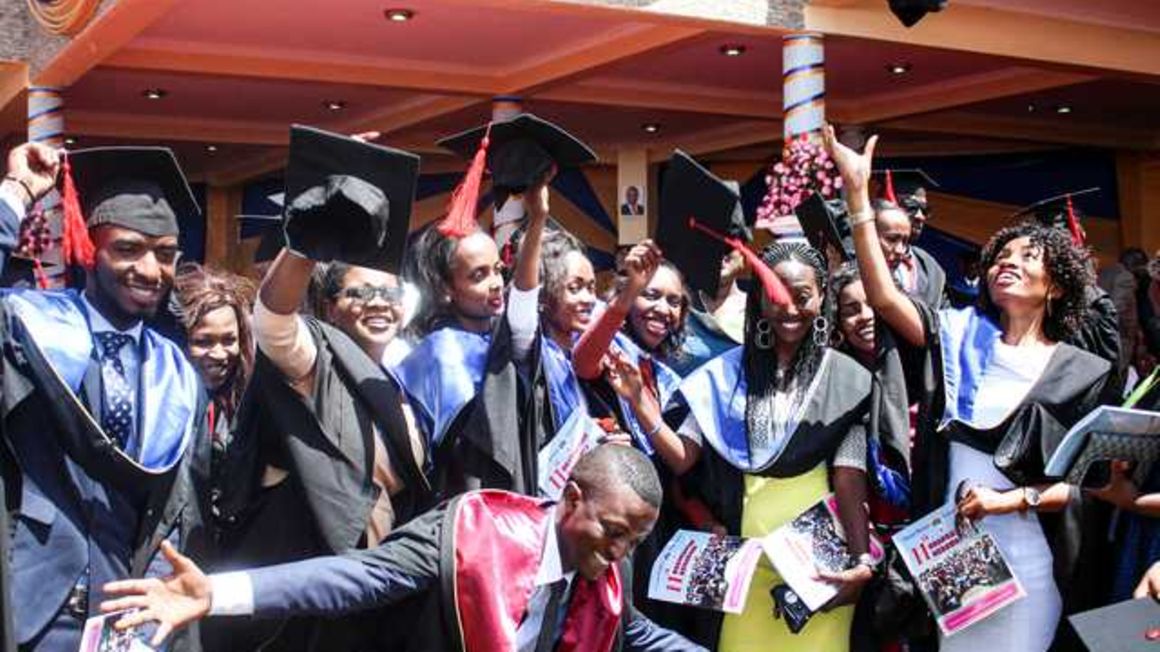
Mount Kenya University graduands celebrate during the graduation ceremony in Thika. FILE PHOTO | DENNIS ONSANGO | NMG
Private universities expect to reap from a policy shift by the government to drop the
current funding formula where all students who score C+ and above get State sponsorship to universities, irrespective of the income of their families.Simon Gicharu, chair of the National Association of Private Universities in Kenya (Napuk), says the shift to only fund needy students will create an equal playing field for private and public universities to compete for the learners based on facilities and fee rates.
Plans are underway for the government to change the funding formula for university students to only fund learners who qualify but are not able to pay their fees, in a bid to ease pressure on the Exchequer.
Read: Varsities woes deepen as projects cash cut by 60pc
The University Funding Board — the State agency that guides allocations of student funds to universities — proposed a funding formula that, if adopted, would prevent students from rich homes from accessing State funding.
“We support the policy. The Treasury should only fund students who cannot afford to pay, and that is why based on fees rates and facilities, we stand an equal chance of getting students who can pay for themselves,” said Prof Gicharu.
“This (change) will take the private universities back to where they are supposed to be, purely independent because that policy of uniformly funding all students with a C+ has not worked for us.”
Kenya lowered the university entry marks to C+ in 2016, and the Treasury was expected to pay part of the costs for State-sponsored students admitted to private and public universities.
But the lowering of the university entry mark dried up the pool of students that private universities could tap, ultimately hurting their cash flows.
Some universities have been forced to sell some of their buildings, and close some campuses in a bid to ease the cash crunch.
The government pays an average of Sh44,000 per year for every State-sponsored student in private universities compared to the Sh125,000 offered in public universities.
But the Treasury has since failed to match capitation to the number of government-sponsored students joining the institutions.
Official data shows that the funding gap for government-sponsored students in private universities was Sh24.38 billion in the year ended June 2021 and has remained on the rise with every enrollment.
Napuk has previously raised concerns about the current funding formula saying it unfairly allocates less cash to State-sponsored joining private varsities compared to their colleagues in public universities.
The lobby also warned the unfair funding criteria would prompt some private universities to opt out of the programme.
The United States International University and Strathmore University are the two high-profile private varsities that do not admit State-sponsored students.
Private universities are now pinning their hopes on a competitive fee structure for lucrative courses like medicine.
The University of Nairobi increased fees for new students in 2021 and Vice-Chancellors of other public varsities are pushing for a similar move.
The fee increments will set the stage for a fresh battle with their private counterparts for students from wealthy families when the government starts funding only needy learners.
Read: UoN and Eldoret university take biggest hit in funding
UF presented the proposed funding formula to Treasury for consideration and adoption, which is expected to be in the financial year starting July.
President William Ruto has also backed the plan to only fund university students from poor households and the public backing by the head of State increased the likelihood of the model being adopted.
Some of the private universities that have not sunk into financial woes have heavily invested in facilities, giving them an edge over their public counterparts.
Public universities on the other hand are grappling with deteriorating facilities amid cash-flow woes occasioned by mismanagement, low funding from the Treasury and drying up of the pool of parallel students.
→ jmutua@ke.nationmedia.com




No comments :
Post a Comment